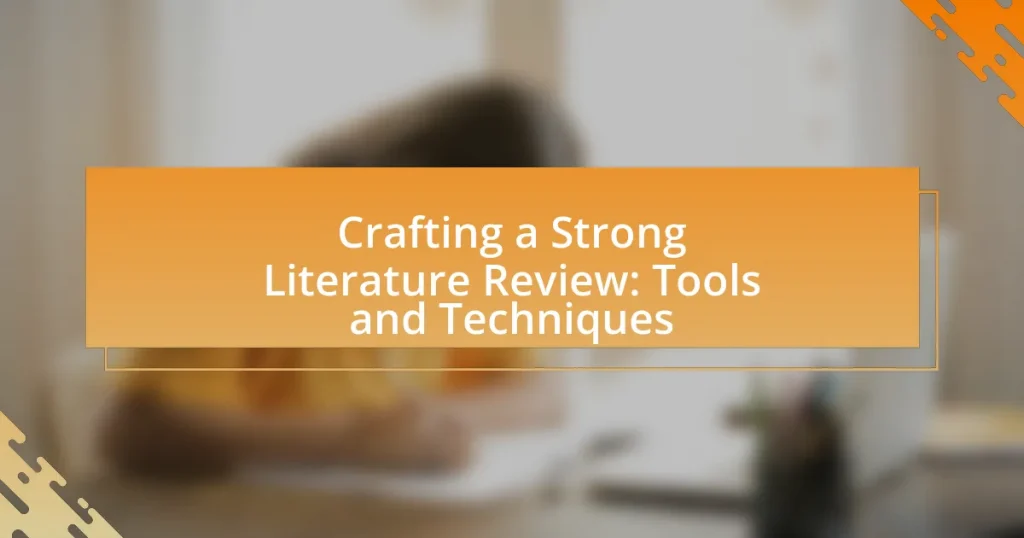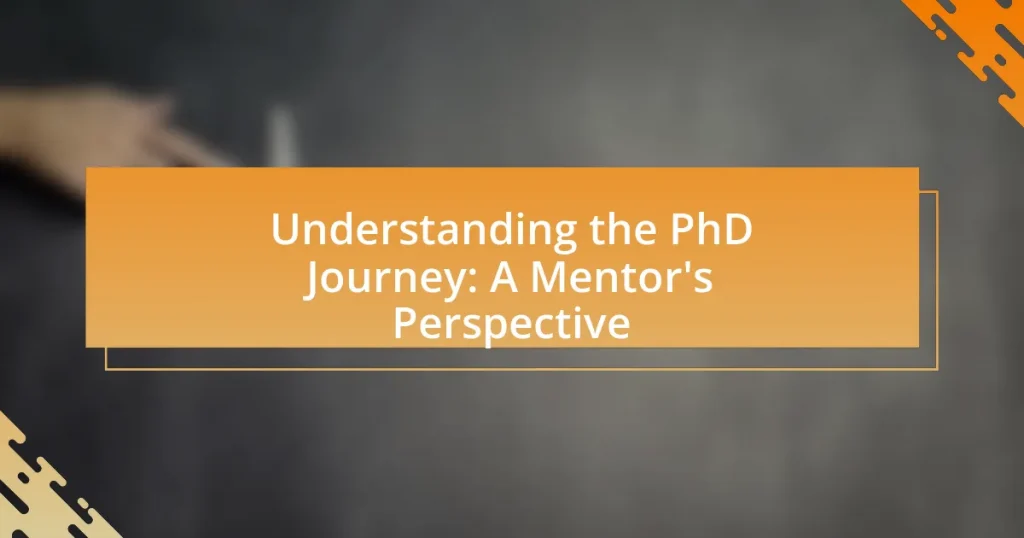A strong literature review is a critical analysis that synthesizes existing research on a specific topic, identifies gaps, and establishes a framework for new studies. This article outlines the importance of literature reviews in research, detailing their role in providing context, enhancing credibility, and guiding the research process. Key components of an effective literature review include a clear research question, comprehensive search strategies, critical analysis of sources, and thematic organization. Additionally, the article discusses essential tools and techniques for crafting literature reviews, such as reference management software, academic databases, and systematic searching methods, while also addressing common pitfalls and strategies to ensure balanced representation and avoid bias.

What is a Strong Literature Review?
A strong literature review is a comprehensive and critical analysis of existing research on a specific topic. It synthesizes relevant studies, identifies gaps in the literature, and establishes a framework for understanding the current state of knowledge. A strong literature review not only summarizes findings but also evaluates the methodologies and theoretical frameworks used in previous research, providing context for the new study. This approach ensures that the review contributes to the academic discourse by highlighting areas for further investigation and demonstrating the significance of the research question.
Why is a literature review important in research?
A literature review is important in research because it provides a comprehensive overview of existing knowledge on a specific topic, identifying gaps and establishing a context for new research. By synthesizing previous studies, researchers can build upon established findings, ensuring their work is relevant and grounded in the current academic discourse. Furthermore, a well-conducted literature review enhances the credibility of the research by demonstrating thorough engagement with existing literature, which is essential for justifying the research question and methodology.
What role does a literature review play in establishing context?
A literature review plays a crucial role in establishing context by synthesizing existing research and identifying gaps in knowledge. This synthesis allows researchers to frame their study within the broader academic conversation, demonstrating how their work builds upon or diverges from previous findings. For instance, a literature review can highlight trends, methodologies, and theoretical frameworks that inform the current research, thereby situating it within a specific scholarly landscape. By doing so, it provides a foundation for understanding the significance of the new study and justifies its relevance to ongoing discussions in the field.
How does a literature review contribute to the research process?
A literature review contributes to the research process by synthesizing existing knowledge and identifying gaps in the current understanding of a topic. This synthesis allows researchers to build upon previous work, ensuring that their studies are grounded in established findings. For instance, a comprehensive literature review can reveal trends, methodologies, and theoretical frameworks that have been effective in past research, guiding new investigations. Additionally, it helps to refine research questions and hypotheses by highlighting areas that require further exploration, thus enhancing the overall quality and relevance of the research.
What are the key components of a strong literature review?
A strong literature review consists of several key components: a clear research question, a comprehensive search strategy, critical analysis of sources, thematic organization, and synthesis of findings. The research question guides the focus of the review, ensuring relevance and clarity. A comprehensive search strategy involves systematically identifying and selecting relevant literature, which enhances the review’s depth. Critical analysis of sources assesses the credibility, relevance, and contributions of each work, allowing for informed evaluations. Thematic organization categorizes the literature into coherent themes, facilitating easier understanding. Finally, synthesis of findings integrates insights from various sources, highlighting gaps and establishing a foundation for future research. These components collectively ensure that the literature review is thorough, coherent, and valuable to the academic community.
What types of sources should be included in a literature review?
A literature review should include a variety of sources such as peer-reviewed journal articles, books, conference papers, theses, and reputable online resources. Peer-reviewed journal articles provide validated research findings, while books offer comprehensive overviews and theoretical frameworks. Conference papers can present cutting-edge research, and theses often contain in-depth studies on specific topics. Reputable online resources, such as government publications and established organizations, can also provide valuable data and insights. Including these diverse types of sources ensures a well-rounded and credible literature review.
How should the literature be organized and presented?
Literature should be organized thematically, chronologically, or methodologically to enhance clarity and coherence. Thematic organization groups studies by common themes or topics, allowing for a focused discussion on specific areas of interest. Chronological organization presents literature in the order of publication, highlighting the evolution of research over time. Methodological organization categorizes studies based on research methods used, facilitating comparisons of approaches and findings. Each method of organization aids in synthesizing information and identifying gaps in the literature, ultimately contributing to a more robust literature review.

What tools can assist in crafting a literature review?
Tools that can assist in crafting a literature review include reference management software, academic databases, and writing aids. Reference management software like EndNote, Mendeley, and Zotero helps organize citations and format bibliographies efficiently. Academic databases such as PubMed, Google Scholar, and JSTOR provide access to a vast array of scholarly articles and research papers, facilitating comprehensive literature searches. Writing aids like Grammarly and Hemingway Editor enhance clarity and coherence in writing, ensuring that the literature review is well-structured and free of grammatical errors. These tools collectively streamline the process of gathering, organizing, and presenting research findings, making the literature review more effective and manageable.
Which software tools are most effective for literature reviews?
The most effective software tools for literature reviews include EndNote, Mendeley, and Zotero. EndNote allows users to manage references and create bibliographies efficiently, supporting various citation styles. Mendeley offers features for organizing research papers, collaborating with others, and generating citations, making it popular among researchers. Zotero is known for its user-friendly interface and ability to save and organize references directly from web browsers. These tools enhance the literature review process by streamlining reference management and improving collaboration among researchers.
How do reference management tools enhance the review process?
Reference management tools enhance the review process by streamlining the organization and citation of sources. These tools allow researchers to easily collect, manage, and format references, which reduces the time spent on manual citation and increases accuracy. For instance, tools like EndNote and Zotero automatically generate citations in various styles, ensuring compliance with publication standards. Additionally, they facilitate collaboration among researchers by enabling shared libraries and annotations, which enhances the collective review of literature. Studies have shown that using reference management software can significantly improve the efficiency of literature reviews, allowing researchers to focus more on analysis and synthesis rather than administrative tasks.
What features should one look for in literature review software?
Literature review software should include features such as reference management, annotation capabilities, collaboration tools, and integration with databases. Reference management allows users to organize citations efficiently, while annotation capabilities enable highlighting and note-taking directly on documents. Collaboration tools facilitate teamwork among researchers, and integration with databases ensures seamless access to academic resources. These features enhance the overall efficiency and effectiveness of conducting literature reviews, as supported by studies indicating that organized citation management significantly reduces the time spent on research tasks.
What online databases are essential for literature review research?
Essential online databases for literature review research include PubMed, Scopus, Web of Science, and Google Scholar. PubMed provides access to a vast collection of biomedical literature, making it crucial for health-related research. Scopus and Web of Science offer comprehensive coverage of peer-reviewed journals across various disciplines, facilitating interdisciplinary research. Google Scholar serves as a broad search engine for scholarly articles, enhancing accessibility to diverse sources. These databases are widely recognized for their extensive indexing and citation tracking capabilities, which are vital for conducting thorough literature reviews.
How can academic databases improve the quality of sources?
Academic databases improve the quality of sources by providing access to peer-reviewed and scholarly articles, which ensures that the information is credible and reliable. These databases, such as JSTOR and PubMed, curate content that has undergone rigorous evaluation by experts in the field, thereby filtering out non-scholarly materials. Furthermore, academic databases often include citation metrics and impact factors, allowing researchers to assess the relevance and influence of sources. This structured approach to sourcing enhances the overall integrity of literature reviews by ensuring that only high-quality, validated research is included.
What strategies can be used to effectively search these databases?
To effectively search databases, utilize advanced search techniques such as Boolean operators, which allow for more precise queries by combining keywords with operators like AND, OR, and NOT. This method enhances search results by narrowing or broadening the scope based on specific needs. Additionally, employing filters such as publication date, document type, and subject area can refine results further, ensuring relevance to the research topic. Utilizing database-specific tools, such as citation tracking and thesaurus features, can also improve search efficiency by identifying related works and alternative terminology. These strategies are supported by research indicating that structured search approaches yield higher-quality literature results, as demonstrated in studies on information retrieval effectiveness.

What techniques can improve the quality of a literature review?
To improve the quality of a literature review, researchers should employ systematic searching, critical appraisal, and thematic synthesis. Systematic searching involves using comprehensive databases and specific keywords to ensure a thorough collection of relevant literature, which enhances the breadth of the review. Critical appraisal requires evaluating the quality and relevance of each source, ensuring that only credible and significant studies are included, thereby increasing the reliability of the findings. Thematic synthesis organizes the literature into coherent themes, allowing for a clearer understanding of trends and gaps in the research. These techniques collectively enhance the rigor and depth of the literature review, leading to more robust conclusions.
How can one develop a clear research question for the review?
To develop a clear research question for a literature review, one should start by identifying a specific topic of interest within the broader field. This involves narrowing down the focus to a particular aspect that is both relevant and researchable. For instance, if the general topic is climate change, a clear research question could be, “How does urbanization impact local climate patterns?” This question is specific, measurable, and addresses a gap in existing literature.
Additionally, reviewing existing studies helps refine the question by highlighting what has already been explored and where further inquiry is needed. According to the framework established by Creswell in “Research Design: Qualitative, Quantitative, and Mixed Methods Approaches,” a well-defined research question guides the research process and ensures that the literature review remains focused and relevant.
What methods can be used to refine and focus the research question?
To refine and focus a research question, researchers can utilize methods such as narrowing the scope, specifying the population, and clarifying the variables involved. Narrowing the scope involves limiting the question to a specific aspect of a broader topic, which helps in making the research more manageable and targeted. For example, instead of asking about the effects of social media on mental health in general, a more focused question could examine the impact of Instagram on anxiety levels among teenagers. Specifying the population further hones in on the demographic of interest, allowing for more relevant findings. Clarifying the variables ensures that the question is precise and measurable, which is essential for effective research design. These methods are supported by research practices that emphasize the importance of specificity in formulating research questions to enhance clarity and direction in studies.
How does a well-defined question guide the literature review process?
A well-defined question directs the literature review process by establishing clear parameters for research focus. This clarity enables researchers to identify relevant studies, theories, and methodologies that directly address the question, thereby streamlining the search for pertinent literature. For instance, a specific question narrows down the scope of inquiry, allowing for a more efficient review of existing work and minimizing the risk of including irrelevant information. Research by Booth, Colomb, and Williams in “The Craft of Research” emphasizes that a focused question enhances the ability to synthesize findings and identify gaps in the literature, ultimately leading to a more coherent and impactful review.
What are best practices for synthesizing literature?
Best practices for synthesizing literature include organizing sources thematically, critically evaluating the quality of each study, and identifying gaps in the existing research. Organizing sources thematically allows for a clearer understanding of trends and patterns within the literature. Critical evaluation ensures that only high-quality, relevant studies inform the synthesis, which enhances the credibility of the review. Identifying gaps helps to highlight areas for future research, making the literature review more impactful. These practices are supported by guidelines from the American Psychological Association, which emphasize the importance of systematic approaches in literature reviews to ensure comprehensive and unbiased synthesis.
How can thematic analysis enhance the synthesis of literature?
Thematic analysis enhances the synthesis of literature by systematically identifying, analyzing, and reporting patterns or themes within qualitative data. This method allows researchers to distill complex information into coherent themes, facilitating a clearer understanding of the literature’s overarching narratives and trends. By organizing findings around these themes, thematic analysis enables a more structured comparison of studies, highlighting similarities and differences that may not be immediately apparent. This approach is supported by Braun and Clarke’s framework, which emphasizes the importance of rigor in thematic analysis, ensuring that the synthesis is both comprehensive and reflective of the data’s richness.
What techniques can be used to identify gaps in the literature?
Techniques to identify gaps in the literature include systematic reviews, citation analysis, and thematic analysis. Systematic reviews synthesize existing research to highlight areas lacking comprehensive study, while citation analysis examines the frequency and context of citations to reveal under-researched topics. Thematic analysis involves categorizing existing literature to uncover patterns and inconsistencies, thereby identifying areas needing further exploration. These methods are validated by their widespread use in academic research, demonstrating their effectiveness in uncovering gaps in various fields.
What common pitfalls should be avoided when crafting a literature review?
Common pitfalls to avoid when crafting a literature review include failing to define a clear research question, which can lead to a disorganized review lacking focus. Additionally, neglecting to critically analyze sources instead of merely summarizing them results in a superficial understanding of the literature. Another significant pitfall is the omission of relevant studies, which can create bias and weaken the review’s credibility. Lastly, poor organization and structure can confuse readers, making it difficult to follow the argument or narrative. These pitfalls undermine the effectiveness of the literature review and can diminish its contribution to the field.
How can one ensure a balanced representation of sources?
To ensure a balanced representation of sources, one should systematically include diverse perspectives and types of sources in the literature review. This can be achieved by actively seeking out literature from various authors, disciplines, and methodologies, ensuring that no single viewpoint dominates the discussion. For instance, a review that incorporates peer-reviewed articles, books, and grey literature from different geographical regions and cultural contexts will provide a more comprehensive understanding of the topic. Research indicates that a balanced literature review enhances the credibility and depth of analysis, as demonstrated in studies like “The Importance of Diverse Perspectives in Literature Reviews” by Smith and Jones, published in the Journal of Research Methodology, which emphasizes that inclusivity in source selection leads to more robust conclusions.
What strategies can help avoid bias in the literature review?
To avoid bias in the literature review, researchers should employ strategies such as comprehensive literature searches, inclusion of diverse sources, and critical appraisal of studies. Comprehensive literature searches ensure that a wide range of studies is considered, reducing the likelihood of overlooking relevant research. Inclusion of diverse sources, including peer-reviewed articles, grey literature, and studies from various geographical and cultural contexts, helps to present a balanced view. Critical appraisal of studies involves evaluating the quality and relevance of each source, which aids in identifying potential biases in the research itself. These strategies collectively enhance the objectivity and reliability of the literature review.
What practical tips can enhance the literature review process?
To enhance the literature review process, researchers should adopt systematic approaches such as creating a structured outline, utilizing reference management software, and conducting comprehensive keyword searches. A structured outline helps organize thoughts and ensures all relevant topics are covered, while reference management software like EndNote or Zotero streamlines citation and organization of sources. Comprehensive keyword searches across multiple databases increase the likelihood of capturing all pertinent literature, as studies show that diverse search strategies yield more comprehensive results (Higgins et al., 2019).



